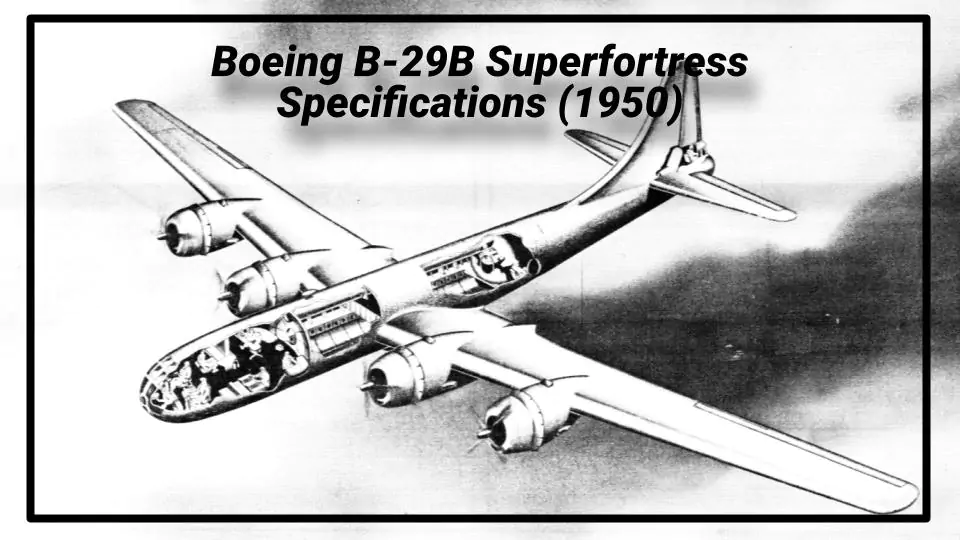
Mission
The main objective of the B-29B is to destruct enemy materials and facilities through aerial bombardment.
Development
The B-29B, a lightened version of the Superfortress, was exclusively manufactured by Bell-Atlanta. Production commenced with the first acceptance from Bell in January 1945 and was completed by September 1945. Instead of being ordered in a single large batch, the B-29Bs were ordered in small batches, sometimes individually, from the B-29-BA production lines. Between January and September 1945, a total of 311 B-29Bs were constructed.
Differences with B-29
The B-29B is a streamlined version of the B-29 airplane, featuring several notable modifications. These changes include a transfer type fuel system, a reduced crew of ten, the removal of all turrets and accessories except for the tail turret (which houses three .50 caliber guns and a gunner), smooth closures for all turret and sight openings, and the incorporation of radar systems for navigation, bombing through overcast conditions, and night fighter protection in the tail.
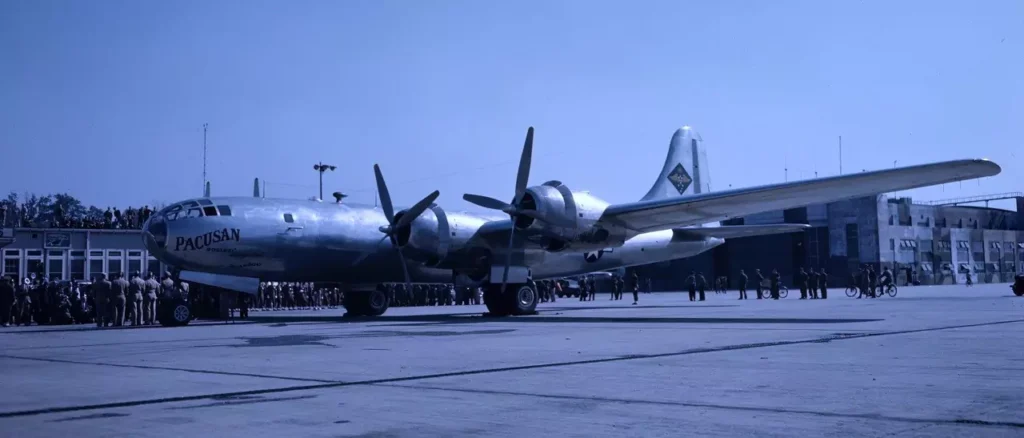
Distinguishing B-29Bs from the ‘ordinary’ B-29s, which were also stripped of their machine gun turrets to save weight during General LeMay’s firebombing campaign against Japan in 1945, can be challenging. However, the B-29Bs can be identified by their serial numbers and the presence of an external radar antenna located at the extreme tail.
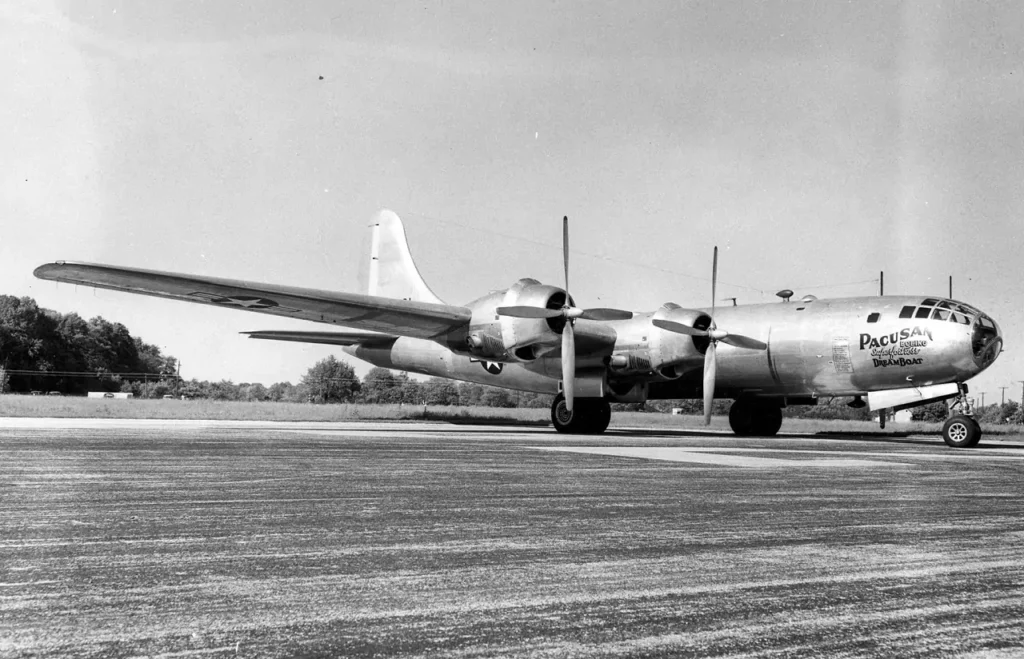
Dimensions and Weights
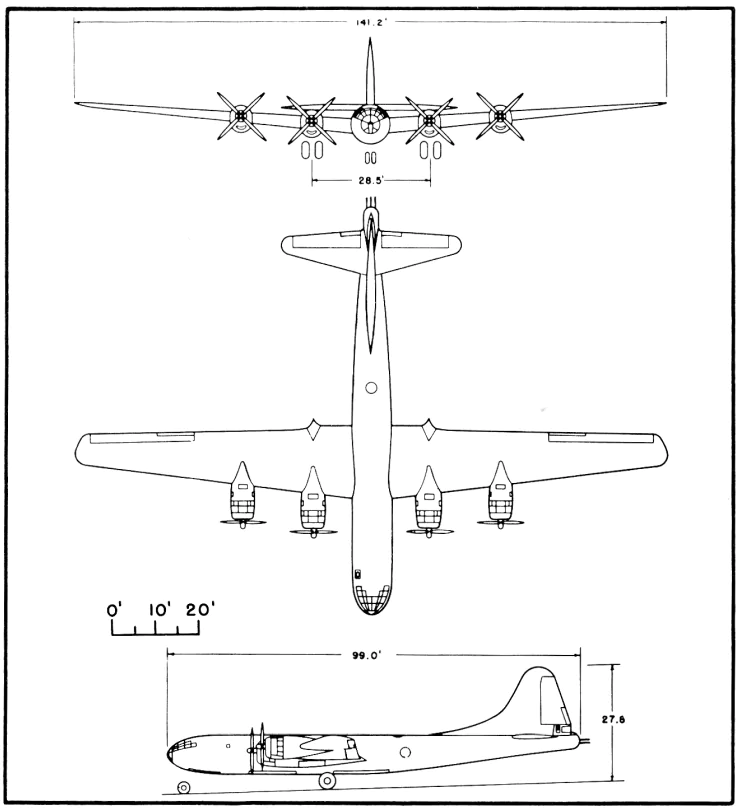
| DIMENSIONS | Imperial | Metric |
|---|---|---|
| Wing | ||
| 141.2 ft | 43 m | |
| 4° | 4° | |
| 4°29'23" | 4°29'23" | |
| 7°1'26" | 7°1'26" | |
| 1720 ft2 | 159.8 m2 | |
| 11.5 | 11.5 | |
| Boeing 117 | Boeing 117 | |
| 154.41 | 47.1 m | |
| Length | 99 ft | 30.2 m |
| Height | 27.8 ft | 8.5 m |
| Tread | 28.5 ft | 8.7 m |
| Prop. Grd Clearance | 1.3 ft | 0.4 m |
| WEIGHTS | ||
| Loading | ||
| 68,821 lbs | 31.217 kg | |
| 68,821 lbs | 32.061 kg | |
| Operating | ||
| 120,000 lbs | 54.431 kg | |
| 96,126 lbs | 43.602 kg | |
| 137,014 lbs | 62.149 kg | |
| 135,000 lbs | 61.235 kg |
(A) Actual
(*) For basic mission
(1) Limited by performance
(2) Limited by gear strength
Engines
| Attribute | Value |
|---|---|
| POWER PLANT | |
| (4) R-3350-57 or-57A | |
| Curtiss - Wright Corp., Wright Aeronautical Corp. Division | |
| 95-28266-5 | |
| (Dual Turbo) B-11 or B-31 | |
| 0.35 | |
| PROPELLER | |
| United Aircraft Corp., Hamilton Standard Propeller Division | |
| 6521A-6 | |
| Hydromatic | |
| 4 | |
| 16' 7" (5 m) | |
| ENGINE RATINGS | |
| 2200/2800rpm | |
| 2200/2600rpm/2500ft | |
| 2000/2400rpm/4000ft |
Electronics
The electronic suite of the B-29B, as of 1950, consisted of the following components:
| Equipment | US Designation |
|---|---|
| VHF Command | AN/ARC-3 |
| Interphone | AN/AIC-2A |
| Liaison | AN/ARC-8 |
| Radio Compass | AN/ARN-7 |
| Marker Beacon | RC-193A |
| Homing Adapter | AN/ARR-1 |
| Localizer | RC-103 |
| Glide Path | AN/ARN-5A |
| Radio Altimeter | SCR-718C |
| Interrogator | SCR-729 |
| Radar | AN/APQ-7 or AN/APQ-23A |
| Loran | AN/APN-9 or AN/APN-4 |
| IFF | SCR-695 |
| Raven | RCM |
Crew

The B-29B’s crew composition was streamlined due to the changes in its defensive armament. As a result, right and left-side gunners were no longer needed, and the central fire control gunner sometimes served as an observer. Additionally, the radar operator could often take on the bombardier’s responsibilities. This allowed the aircraft to operate with a reduced crew of seven to eight members, as fewer gunners were necessary.
However, the B-29B typically carried up to ten crew members including two scanners. The role of the scanners was to keep an eye out for both friendly and enemy aircraft in the vicinity.
The B-29B crew list was:
- Pilot
- Co-pilot
- Navigator
- Flight engineer
- Bombardier
- Radio operator
- Radar operator
- Left scanner
- Right scanner
- Tail gunner
Fuel system
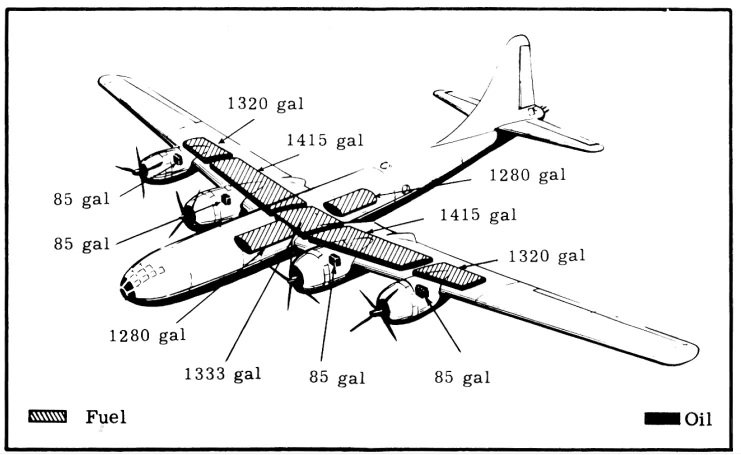
| Location | No. Tanks | Gals | Liters |
|---|---|---|---|
| Wing, outbond* | 2 | 2640 | 9993 |
| Wing, inbound* | 2 | 2830 | 10713 |
| Wing, center* | 1 | 1333 | 5046 |
| Bomb bay | 2 | 2560 | 9691 |
| Total | 9363 | 35443 |
(*) Self Sealing tanks
Bombs and Guns
Defensive armament
The B-29B aircraft underwent modifications to its defensive armament in response to combat experiences in the Pacific, where the primary enemy fighter attacks were observed to come from the rear. As a result, all fuselage turrets, removable turret structures, related turret equipment, and armament were removed, leaving only the tail gun and sighting station. Flush covers were placed over the turret and sighting blister locations.
The tail gun was upgraded with the addition of a third .50cal machine gun, increased ammunition provisions, and an advanced AN/APG-15B airborne radar-directed fire control system called the Airborne Radar Gun Sighting System. This innovative system was designed to detect approaching enemy aircraft, lock on to them, and automatically fire the necessary guns. It made all the necessary calculations for tracking and firing on enemy aircraft by coupling to the GE gun computer and IFF (“Ella”) units.
To reduce weight, the armor was removed from the B-29B except for the glass in front of the airplane commander’s position and the armor and glass in the tail gunner’s position. Flak protection was also removed, except for the Dural plate situated behind the airplane commander’s position.
| No. | Calibre/ Rounds each | Location |
|---|---|---|
| 2 | .50 / 500 | Tail turret |
| 1 | .50 / 380 | Tail turret |
Bombs
In practice, the B-29B was capable of carrying even larger payloads by operating at lower altitudes, which optimized fuel consumption. While its maximum bomb load was 20,000 lb, it could reach up to 22,800 lb when carrying a mixed incendiary load.
| No. | Size | Type |
|---|---|---|
| 4 | 4000 lbs | General-purpose (G.P.) |
| 8 | 2000 lbs | General-purpose (G.P.) |
| 12 | 1600 lbs | Armor-piercing (A.P.) |
| 12 | 1000 lbs | General-purpose (G.P.) |
| 40 | 500 lbs | General-purpose (G.P.) |
Performance
By removing the turrets and the related General Electric computerized gun system, the B-29B Superfortress gained an increase in top speed. This made the aircraft well-suited for swift, unescorted bombing raids and reconnaissance missions that relied on hit-and-run tactics.
The basic performance of the B-29B was the following:
Combat radius
2122 nm
with 10,000 lb of payload at 208 knots avg. in 20.66 hours
Combat range
3926 nm
with 10,000 lb of payload at 191 knots avg. in 20.73 hours
Combat speed
344 kn
at 25,000 ft alt, max power
Maximum speed
360 kn
at 30,000 ft alt, max power
Climb
618/1820
fpm sea level, take-off weight normal power
/fpm sea level, combat weight max power
Ceiling
30,250/
38,000 ft
100 fpm, take-off weight, normal power
/500 fpm, combat weight max power
Loading and Performance
Basic mission, Max bombs mission, High alt. mission
| Conditions | Basic mission | Max Bombs Mission | ||
|---|---|---|---|---|
| TAKE-OFF WEIGHT | 135,744 lb | 61.572 kg | 136,464 lb | 61.899 kg |
| 48,498 lb | 21.998 kg | 40,818 lb | 18.515 kg | |
| 10,000 lb | 4.536 kg | 20,000 lb | 9.072 kg | |
| 79.0 lb/sq ft | 385,7 kg/m2 | 79.3 lb/sq ft | 387.,1 kg/m2 | |
| 102 kn | 189 km/h | 102 kn | 189 km/h | |
| 4,800 ft | 1.463 m | 4,860 ft | 1.481 m | |
| 7,125 ft | 2.172 m | 7,225 ft | 2.202 m | |
| 618 fpm | 188 m/min | 602 fpm | 183 m/min | |
| 18.5 min | 18.8 min | |||
| 43.5 min | 45.0 min | |||
| 30,250 ft | 9.220 m | 29,900 ft | 9.114 m | |
| 26,200 ft | 7.986 m | 25,800 ft | 7.864 m | |
| COMBAT RANGE | 3,926 n.mi | 7.271 km | 3,076 n.mi | 5.697 km |
| 191 kn | 354 km/h | 195 kn | 361 km/h | |
| 10,000 ft | 3.048 m | 10,000 ft | 3.048 m | |
| 20.73 hr | 15.94 hr | |||
| COMBAT RADIUS (5) | 2,122 n.mi | 3.930 km | 1,725 n.mi | 3.195 km |
| 208 kn | 385 km/h | 210 kn | 389 km/h | |
| 10,000 ft & 25,000 ft | 3.048 m & 7.620 m | 10,000 ft & 25,000 ft | 3.048 m & 7.620 m | |
| 20.66 hr | 16.69 hr | |||
| COMBAT WEIGHT (6) | 96,126 lb | 43.602 kg | 92,353 lb | 41.891 kg |
| 25,000 ft | 7.620 m | 25,000 ft | 7.620 m | |
| 344 kn | 637 km/h | 345 kn | 639 km/h | |
| 1,480 fpm | 451 m/min | 1,610 fpm | 491 m/min | |
| 38,000 ft | 11.582 m | 38,750 ft | 11.811 m | |
| 41,400 ft | 12.619 m | 42,300 ft | 12.893 m | |
| 37,200 ft | 11.339 m | 38,100 ft | 11.613 m | |
| 1,820 fpm | 555 m/min | 1,925 fpm | 587 m/min | |
| 360 kn | 667 km/h | 361 kn | 669 km/h | |
| LANDING WEIGHT | 78,071 lb | 35.412 kg | 77,687 lb | 35.238 kg |
| 2,100 ft | 640 m | 2,090 ft | 637 m | |
| 2,800 ft | 853 m | 2,790 ft | 850 m | |
NOTES
(1) Take-off power
(2) Max power
(3) Normal power
(4) Take-off and landing distances are obtainable at sea level using normal techniques. For airport planning, distances should be increased by appropriate factors to determine runway requirements.
High Alt. Mission, Ferry Range
| Conditions | High Alt. Mission | Ferry Range | ||
|---|---|---|---|---|
| TAKE-OFF WEIGHT | 135,744 lb | 61.572 kg | 135,024 lb | 61.246 kg |
| 48,498 lb | 21.998 kg | 56,178 lb | 25.482 kg | |
| 10,000 lb | 4.536 kg | |||
| 79.0 lb/sq ft | 385,7 kg/m2 | 78.5 lb/sq ft | 383.2 kg/m2 | |
| 102 kn | 189 km/h | 102 kn | 189 km/h | |
| 4,800 ft | 1463 m | 4,725 ft | 1.440 m | |
| 7,125 ft | 2.172 m | 7,025 ft | 2.141 m | |
| 618 fpm | 188 m/min | 625 fpm | 191 m/min | |
| 18,5 min | 18.2 min | |||
| 43,5 min | 43.0 min | |||
| 30,250 ft | 9.220 m | 30,600 ft | 9.327 m | |
| 26,200 ft | 7.986 m | 26,550 ft | 8.092 m | |
| COMBAT RANGE | 3,505 n.mi | 6.491 km | 4,939 n.mi | 9.147 km |
| 267 kn | 494 km/h | 185 kn | 343 km/h | |
| 25,000 ft | 7.620 m | 10,000 ft | 3.048 m | |
| 13.27 hr | 26.83 hr | |||
| COMBAT RADIUS (5) | 1,959 n.mi | 3.628 km | ||
| 235 kn | 435 km/h | |||
| 25,000 ft & 30,000 ft | 7.620 m & 9144 m | |||
| 16.86 hr | ||||
| COMBAT WEIGHT (6) | 95,320 lb | 43.236 kg | 81,263 lb | 36.860 kg |
| 30,000 ft | 9.144 m | 10,000 ft | 3.048 m | |
| 360 kn | 667 km/h | 308 kn | 570 km/h | |
| 1,375 fpm | 419 m/min | 2,210 fpm | 674 m/min | |
| 38,200 ft | 11.643 m | 41,450 ft | 12.634 m | |
| 41,650 ft | 12.695 m | 44,950 ft | 13.701 m | |
| 37,400 ft | 11.400 m | 40,900 ft | 12.466 m | |
| 1,840 fpm | 561 m/min | 2,330 fpm | 710 m/min | |
| 360 kn | 667 km/h | 368 kn | 682 km/h | |
| LANDING WEIGHT | 78,071 lb | 35.412 kg | 81,263 lb | 36.860 kg |
| 2,100 ft | 640 m | 2,180 ft | 664 m | |
| 2,800 ft | 853 m | 2,900 ft | 884 m | |
NOTES
(1) Take-off power
(2) Max power
(3) Normal power
(4) Take-off and landing distances are obtainable at sea level using normal techniques. For airport planning, distances should be increased by appropriate factors to determine runway requirements.
Further reading
- Boeing B-29 Superfortress Specifications (1950)
- Boeing B-29A Superfortress Specifications (1950)
- Boeing KB-29P Superfortress Specifications (1951)
- Boeing SB-29 Superfortress Specifications (1954)
- Tupolev Tu-4 Standard Specification & Performance
- Boeing B-29 Superfortress Facts: 11 things to know
Bibliography
- B-29 Superfortress: Giant Bomber of World War 2 and Korea by Graham Simons
- Boeing B-29 Superfortress: The Ultimate Look: From Drawing Board to VJ-Day by William Wolf
- B-29B Superfortress Standard Aircraft Characteristics 19-APR-1950, Air Materiel Command, U.S. Air Force